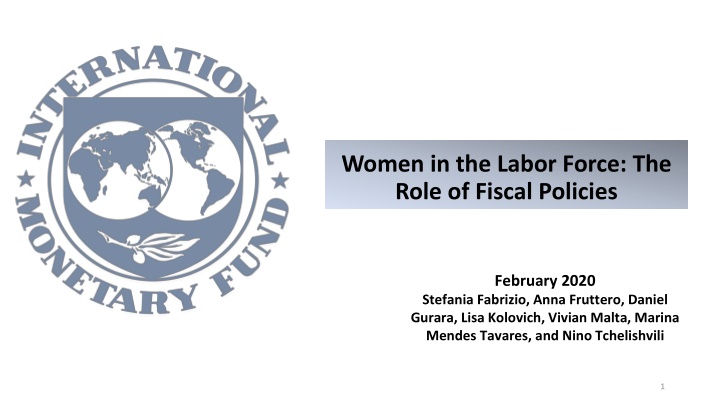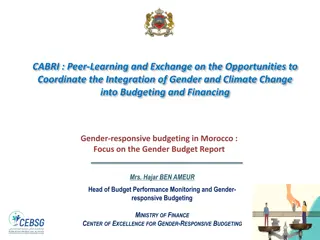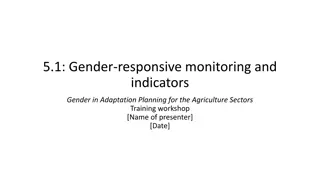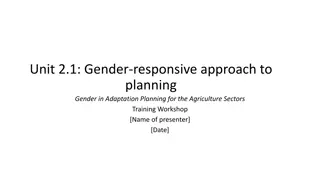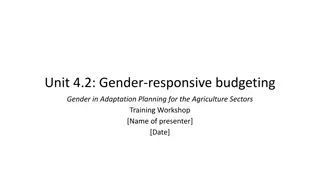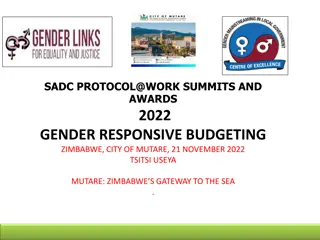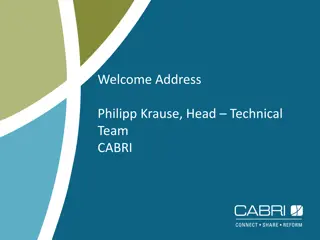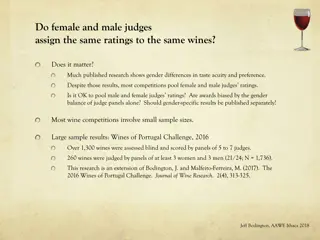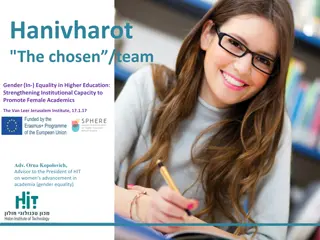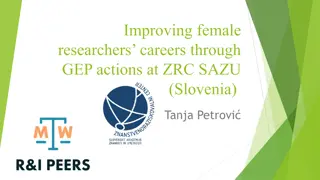Gender-Responsive Fiscal Policies and Female Labor Force Participation
Despite persistent gender gaps in labor force participation and wages, various fiscal policy measures have been adopted globally since the mid-1980s to address these disparities. Understanding the impact of gender-responsive fiscal policies on female labor force participation, economic growth, income inequality, and poverty is crucial for designing effective measures to promote gender equality and enhance overall societal well-being.
Download Presentation

Please find below an Image/Link to download the presentation.
The content on the website is provided AS IS for your information and personal use only. It may not be sold, licensed, or shared on other websites without obtaining consent from the author.If you encounter any issues during the download, it is possible that the publisher has removed the file from their server.
You are allowed to download the files provided on this website for personal or commercial use, subject to the condition that they are used lawfully. All files are the property of their respective owners.
The content on the website is provided AS IS for your information and personal use only. It may not be sold, licensed, or shared on other websites without obtaining consent from the author.
E N D
Presentation Transcript
Women in the Labor Force: The Role of Fiscal Policies February 2020 Stefania Fabrizio, Anna Fruttero, Daniel Gurara, Lisa Kolovich, Vivian Malta, Marina Mendes Tavares, and Nino Tchelishvili 1
Outline Motivation Objectives/scope Main messages Context/stylized facts Impact of gender-responsive fiscal policy measures Main Findings/Policy messages 2
Motivation Despite progress, gender gaps in labor force participation and wages persist Since the mid-1980s, many countries have adopted various fiscal policy measures to address gender gaps Yet, thin evidence on the transmission channels through which fiscal policy measures address gender inequality and affect other economic and social variables It is important to understand the macroeconomic and distributional effects of gender- responsive fiscal policy measures to design effective and sustainable measures to support gender equality while boosting economic growth and reducing income inequality and poverty 3
Objectives/Scope Analyze key transmission channels through which gender-responsive policies impact female labor force participation, economic growth, income inequality and poverty Examine selected fiscal interventions to boost female labor force participation (FLFP) in advanced economies (AEs) and low-income countries (LICs) Aim is not to consider trade-offs among the different measures and rank them 4
Main Messages SDN confirms that gender-responsive fiscal policies can support female labor force participation while positively impacting economic growth, inequality and poverty The transmission channels and impacts of the various policy measures depend on the design of the policies and on country s features, e.g.: education levels education gaps between men and women the size of the informal sector gender-biased social norms
Female labor force participation (FLFP) increased and the gender gap declined 7
but averages mask important differences in trend and levels across countries Panel A. Change, 1990-2018 (Percent, Annual Average) Sources: World Development Indicators and authors' calculations. 8
Fiscal policies positively associated with FLFP in AEs and LICs 9
The Impact of Gender-Responsive Fiscal Policies 10
Methodology: Model Approach Two life-cycle general equilibrium models with heterogeneous agents Calibration done for representative AEs and LICs that allow for the analysis of specific fiscal policy measures (US and Senegal) The analysis sheds light on the transmission channels Impact size is country-specific and subject to model assumptions, therefore, meant only for illustration purposes 11
Policy Experiments LICs Increasing education spending to close the education gap by income level Providing cash transfers to poor working women Increasing infrastructure spending for better access to safe water AEs Reducing childcare cost through subsidies (closer to OECD average) Increasing maternity leave (to match OECD average) Changing the unit of taxation of personal income tax from family to individual 12
The Impact of Gender-Responsive Fiscal Policies in Advanced Economies 13
Subsidizing Child Care Panel A. Change in Female Labor Force Participation by Education Level1 Panel B. Households' Income 0.6 0.5 8 7.3 Change in Percentage Points 6.5 7 0.4 Percentage Change 6 4.8 0.2 4.4 5 -0.2 0.04 4 0 3 2 -0.2 LFP of middle/higher educated women 1 0.0 0.0 -0.4 0 GDP through larger labor force supply Net Income Male Net Income Female Average Household Income Total Gain <HS HS SC C COL+ Poverty Panel C. Income Gaps, Inequality and Poverty3 Panel D. GDP and Government Accounts2 0.1 0.5 0.4 Percentage Change of GDP Change in Percentage Points -0.02 0.00 0.00 -0.02 -0.4 0.4 0.0 0.3 0.3 -0.1 0.2 -0.2 0.1 -0.3 0.0 -0.4 -0.1 Gini Poverty Income Gap Top Decile Income Bottom Decile Income GDP Fiscal Balance Impact 14 <HS (Less than High School), HS (High School), SC (Some College), C (College), COL+ (Post-College)
Extending Paid Maternity Leave Panel A. Change in Female Labor Force Participation by Education Level1 Panel B. Households' Income 0.4 0.35 5.0 5 Change in Percentage Points Percentage Change 0.2 4 0.04 3 0.0 FLFP of low-skilled women 1.9 2 1.6 1.4 -0.2 -0.14 GDP due mostly to larger labor supply 1 0.0 0.0 -0.4 0 Net Income Male Net Income Female Average Household Income Total Gain <HS HS SC C COL+ Poverty among of families with small children Panel C. Income Gaps, Inequality and Poverty3 Panel D. GDP and Government Accounts2 0.30 1.5 Percentage Change of GDP Change in Percentage Points 0.25 1.2 Initial cost potentially large if provided to all women 1.2 0.25 0.9 0.20 0.13 0.6 0.15 0.3 0.10 -0.02 0.0 0.0 -0.3 0.0 0.05 -0.3 0.00 Gini Poverty Income Gap Top Decile Income Bottom Decile Income GDP Fiscal Balance Impact 15 <HS (Less than High School), HS (High School), SC (Some College), C (College),COL+ (Post-College).
Changing the Unit of Taxation Panel A. Change in Female Labor Force Participation by Education Level1 Panel B. Households' Income 20 19.3 20 16 17.9 Change in Percentage Points 18 16.1 15.5 15.3 16 Percentage Change 12 14.9 14 12.2 8 12 4 10 2.0 FLFP among all women Marginal income tax of secondary earners GDP (larger labor supply and higher productivity) Revenue due to larger labor force and higher marginal tax of primary earners Progressivity of labor income tax Poverty and Inequality 8 -7.3 0 6 -4 4 2 -8 0 Net Income Male Net Income Female Average Household Income Total Gain <HS HS SC C COL+ Panel D. GDP and Government Accounts2 Panel C. Income Gaps, Inequality and Poverty3 7.0 8 4 Change in Percentage Points Percentage Change of GDP 3.4 4 1.0 -0.03 -0.04 -15.3 3 0 -4 2 1.5 -8 1 -12 -16 0 Gini Poverty Income Gap Top Decile Income Bottom Decile Income GDP Fiscal Balance Impact 16 <HS(Less than High School), HS (High School), SC (Some College), C (College), COL+ (Post-College)
The Impact of Gender-Responsive Fiscal Policies in Low-Income Countries 17
Closing Education Gap Panel B. Households' Income Panel A. GDP and Government Accounts 10 8.8 11.2 12 8 10 Percentage Change Percentage Change 7.0 8 6 6 Female human capital and productivity 4 4 2 -0.1 2 0.9 0 Returns for less educated women -2 0 Male Wage Female Wage Average Household Income GDP Fiscal Net Revenues-to- GDP Ratio GDP through larger labor supply and higher productivity Panel C. Wage Gap, Inequality and Poverty Panel D. Change in Household's Income 60 0 Change in Percentage Points Opportunities for middle-income working women to enter the formal labor market -5 -2.8 50 Percentage Change -10 -7.7 40 -11.0 -15 30 -20 20 -25 10 -27.6 -30 Wage Gap Gini Top10-to- Bottom10 Income Ratio Poverty 0 1 2 3 4 5 6 7 8 9 10 18 Deciles of Income Distribution Source: Authors' calculations.
Investing in Infrastructure For Safe Water Panel A. GDP and Government Accounts Panel B. Households' Income 14 14.6 13.2 15 13.6 12 Percentage Change 12 Percentage Change 10 9.6 9 8 6 6 FLFP (especially but not only poor women) 4 3 1.3 2 0 0 GDP through larger labor supply and higher productivity Male Wage Female Wage Average Household Income GDP Fiscal Net Revenues-to- GDP ratio Panel C. Wage Gap, Inequality and Poverty Panel D. Change in Household's Income Poverty and inequality 60 0 Change in Percentage Points -1.5 -3.1 -5 50 Percentage Change -4.3 -10 40 -15 30 -20 20 -25 -30 10 -30.2 -35 0 Wage Gap Gini Top10-to- Bottom10 Income Ratio Poverty 1 2 3 4 5 6 7 8 9 10 19 Deciles of Income Distribution Source: Authors' calculations.
Cash transfers to Poor Working Women Panel A. GDP and Government Accounts1 Panel B. Households' Income 4 4 3.8 3.4 Percentage Change of GDP 3 3 Percentage Change 2 2 FLFP of poor (low-skilled) women 1 0.6 1 -0.1 -0.5 0 0 GDP (labor supply effect) -1 -1 Male Wage Female Wage Average GDP Fiscal Balance Impact Household Income Aggregate labor productivity Panel C. Wage Gap, Inequality and Poverty Panel D. Change in Households' Income Poverty and inequality 0 120 -0.4 Change in Percentage Points -4.5 -11 100 Percentage Change -16.3 80 -22 60 -33 40 -44 20 -51.8 Top10-to- Bottom10 Income Ratio -55 Wage Gap Gini Poverty 0 1 2 3 4 5 6 7 8 9 10 20 -20 Deciles of Income Distribution
Tackling GenderBiased Social Norms Social norms/legal barriers affect FLFP: For example, 88 countries still prohibit women from entering certain professions (OECD, 2019) Model-based results suggest that reducing gender-biased social norms magnify all positive effects of gender responsive fiscal policies Countries have introduced various measures to address social biases, examples include: Gender Roles, Equality, and Transformations (GREAT) radio program in Uganda Promundo s Program H in 34 countries Father s quota on parental leave in Germany In Saudi Arabia, men were more likely to support their wives working after participating in peer-learning sessions. 21
Main Findings/Policy Lessons Given the high returns from many gender-responsive policy interventions, it is imperative to analyze the macroeconomic and distributional impacts of gender-responsive fiscal policies. Gender-responsive policies affect FLFP and other economic and social objectives in various ways Different channels Increasing human capital (investing in education) Boosting productivity (changing the unit of taxation, investing in education and infrastructure that disproportionally benefits women) Affecting different parts of the female population (subsidizing child care, extending maternity leave, providing cash transfers to working mothers) Increasing progressivity of taxation without initial fiscal costs (changing the unit of taxation) Different timing Long time to provide returns (investing in education) Potential short-term impact (cash transfers to poor working women) Tackling gender-biased social norms amplifies the effects of all gender-responsive measures
Thank you 23
